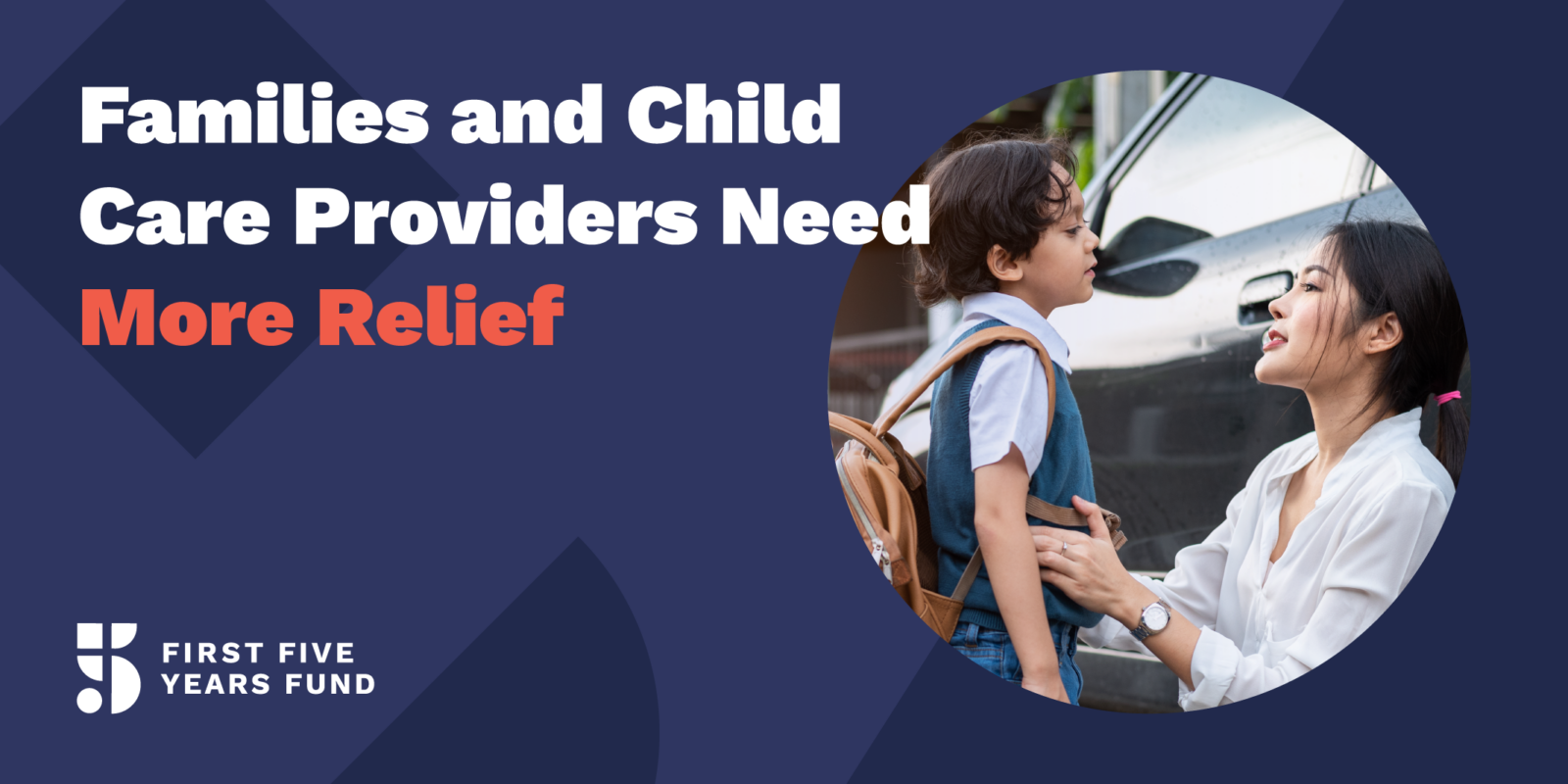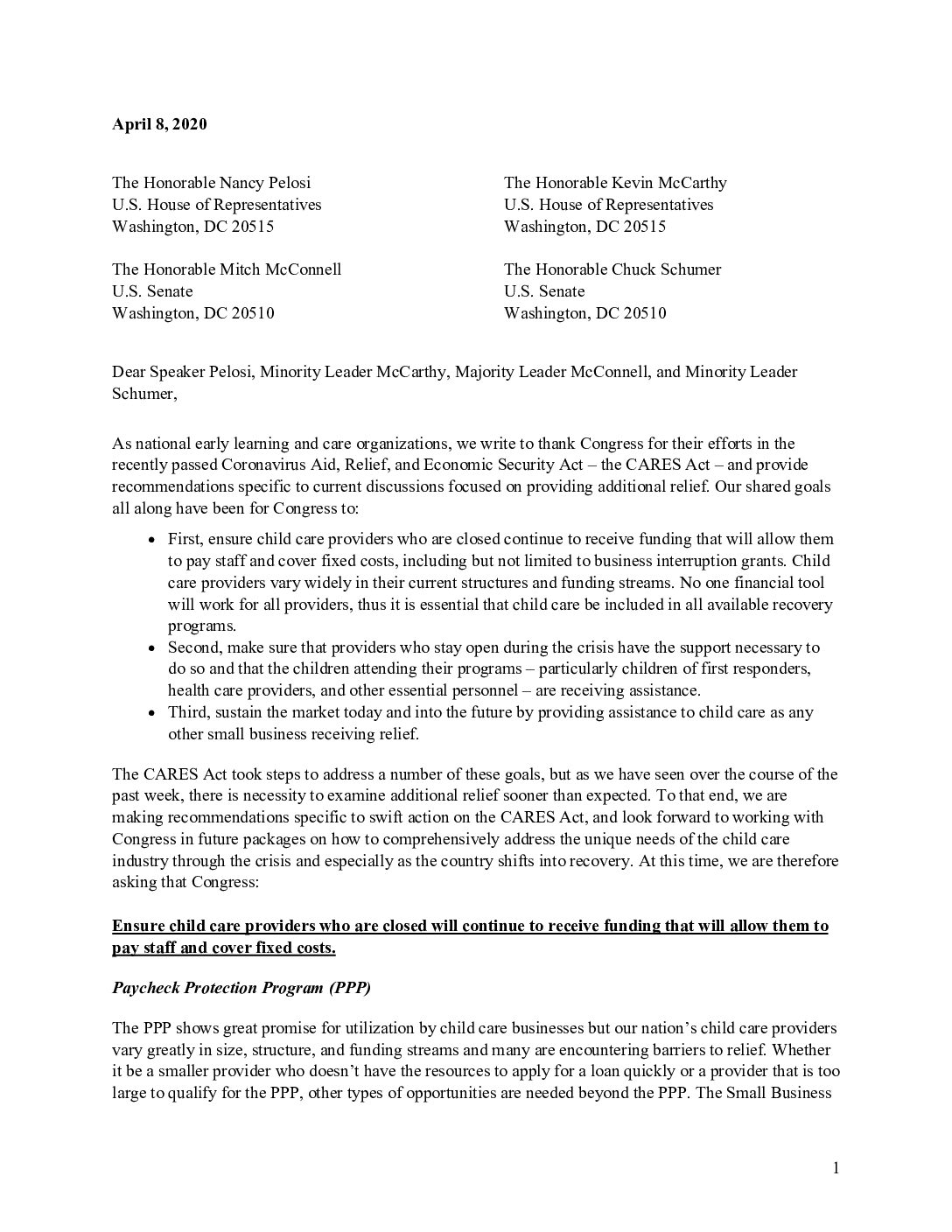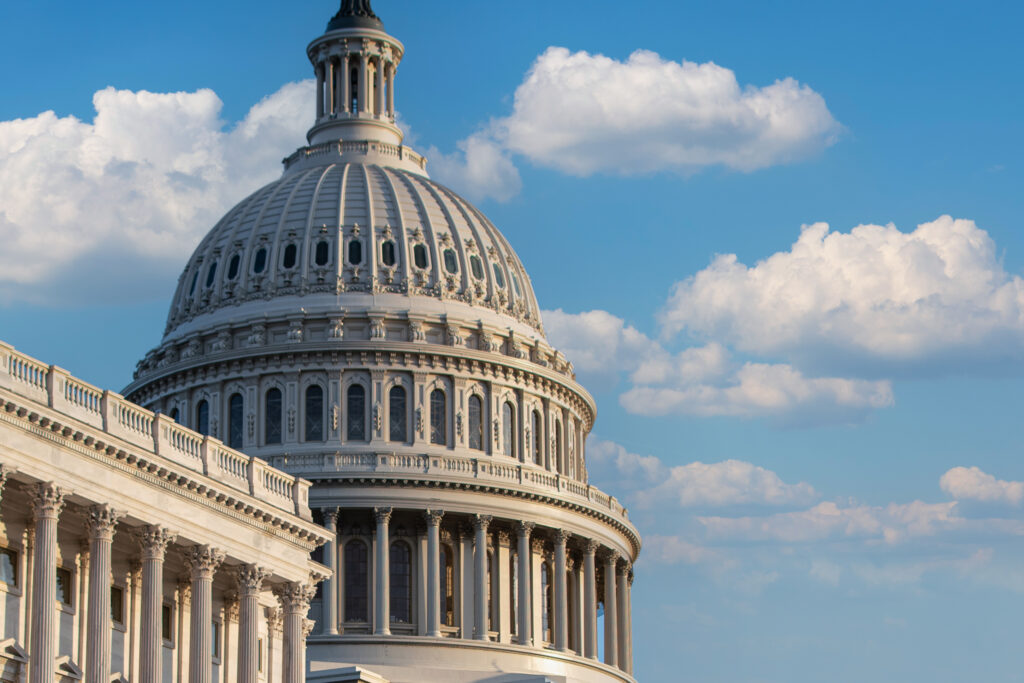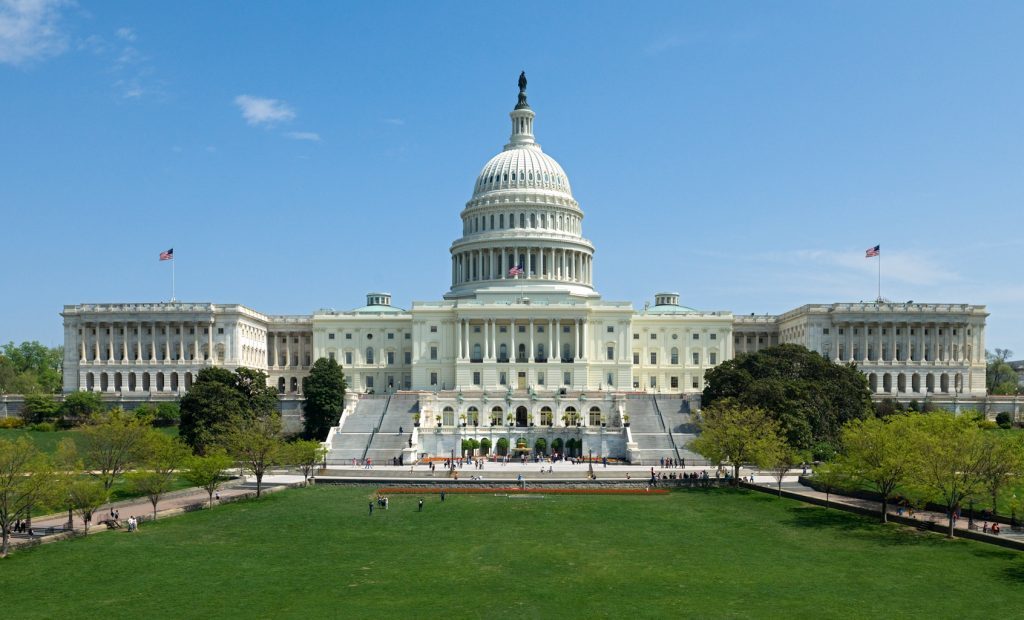FFYF & National Organizations Call for Additional COVID-19 Relief for Child Care Industry

April 8, 2020
The Honorable Nancy Pelosi
U.S. House of Representatives
Washington, DC 20515
The Honorable Mitch McConnell
U.S. Senate
Washington, DC 20510
The Honorable Kevin McCarthy
U.S. House of Representatives
Washington, DC 20515
The Honorable Chuck Schumer
U.S. Senate
Washington, DC 20510
Dear Speaker Pelosi, Minority Leader McCarthy, Majority Leader McConnell, and Minority Leader Schumer,
As national early learning and care organizations, we write to thank Congress for their efforts in the recently passed Coronavirus Aid, Relief, and Economic Security Act – CARES Act – and provide recommendations specific to current discussions focused on providing additional relief. Our shared goals all along have been for Congress to:
- First, ensure child care providers who are closed continue to receive funding that will allow them to pay staff and cover fixed costs, including but not limited to business interruption grants. Child care providers vary widely in their current structures and funding streams. No one financial tool will work for all providers, thus it is essential that child care be included in all available recovery programs.
- Second, make sure that providers who stay open during the crisis have the support necessary to do so and that the children attending their programs – particularly children of first responders, health care providers, and other essential personnel – are receiving assistance.
- Third, sustain the market today and into the future by providing assistance to child care as any other small business receiving relief.
The CARES Act took steps to address a number of these goals, but as we have seen over the course of the past week, there is necessity to examine additional relief sooner than expected. To that end, we are making recommendations specific to swift action on CARES, and look forward to working with Congress in future packages on how to comprehensively address the unique needs of the child care industry through the crisis and especially as the country shifts into recovery. At this time, we are therefore asking that Congress:
Ensure child care providers who are closed will continue to receive funding that will allow them to pay staff and cover fixed costs.
Paycheck Protection Program (PPP)
The PPP shows great promise for utilization by child care businesses but our nation’s child care providers vary greatly in size, structure, and funding streams and many are encountering barriers to relief. Whether it be a smaller provider who doesn’t have the resources to apply for a loan quickly or a provider that is too large to qualify for the Paycheck Protection Program, it has become apparent very quickly that additional funding, in addition to technical program fixes, are needed in order for it to meet the vast needs of the child care and early learning sector as it was intended. To this end we recommend:
- Providing additional funding for the PPP program.
- Prohibiting lenders from establishing conditions that require applicants to be existing customers.
- Small businesses of under 50 employees are provided the funding as grants. If PPP requirements are not met, these grants convert to loans requiring repayment under the guidelines of this program.
- Ensuring small businesses serving “essential workers” as defined in the CARES Act receive categorical priority during the application/approval process and are fast tracked.
- Include
NAICS Code 6244 to a list of exceptions under section 1102 of the CARES Act
whereby businesses are also permitted to calculate the number of employees
based on each physical location, as opposed to the aggregate number of
employees working for the entity as a whole.
- Similar to businesses under NAICS Code 72, child care centers were ordered to be closed by state governments and their revenues have dropped by over 75% overnight.
- Waiving affiliation rules and allowing child care to calculate employees on a center-by-center basis is integral to sustainability.
Economic Stabilization Act
Child care in this country is provided through a diverse delivery system, which includes providers of all sizes. Mid-to-large providers are not eligible for small business relief and have no other recourse to access much needed liquidity to keep their centers open. Yet, the realities facing larger providers are very much the same as any other provider, regardless of size—they need relief to remain open today and into the future. Therefore, given the importance of childcare services to the U.S. economy, to address the overall needs of the sector Congress should:
- Direct the Treasury Department working with the Federal Reserve to establish a program or facility available for mid-to-large child care providers to address liquidity shortfalls under section 4003(b)(4) of Title IV of the CARES Act. At the very least, as providers of an essential service vital to the economic recovery of the nation, child care providers should be given categorical priority and have applications and approval process fast tracked.
- The program for early childhood education and childcare services must also be flexible in its terms and conditions, including collateral requirement and solvency requirements, so that mid-to-large child care providers may qualify.
Ensuring that mid-to-large providers have access to much needed liquidity will allow them to stay open during the crisis to care for the children of first responders and other essential personnel. Access to loans or grant funding will also allow providers to reopen for America’s workforce once economic recovery begins. If Congress does not take immediate action, mid-to-large providers will close permanently. The loss of these providers will have a direct impact on the ability of parents to re-enter the workforce once the pandemic ends, and will lead to a significantly slower recovery for the U.S. economy.
To make sure that providers who are staying open during the crisis have the support necessary to do so and that the children attending their programs – particularly children of first responder, health care providers, and other essential personnel – are receiving assistance.
Child Care Development Block Grant (CCDBG)
Many child care facilities are being asked to remain open in order to provide care in this time of incredible need and uncertainty and the CARES Act recognizes the unique role child care providers are playing, as well as the need for care by essential workers at this time. We recommend additional resources be allocated as funding providing through CARES will not be sufficient to meet these unique needs. Funding should be directed to support:
- Families seeking care as a result of their need as essential workers.
- The increased risks, pay and costs of maintaining services for essential workers, including providing primary protective equipment in order to maintain their health and the sanitation of the facility at all times.
To sustain the market today and into the future by providing direct assistance to child care providers.
What we know is that if we are to truly address the child care needs in this country of families and of our future economy, we must systemically look at what is needed.
We know more assistance and relief will be needed as the harm caused by this horrific pandemic continues to unfold. What we do know, however, is that the statistics we have only just begun tracking paint a stark picture of what’s to come:
- New research from the Center for American Progress (CAP) finds that almost 5 million health care workers—around 29 percent of the entire workforce—have children that are too young to be left home alone as schools and child care programs close. This research does not account for the employees in other industries that are essential to keeping the country running through this crisis, including sanitation workers, the food and beverage industry, and more—a large percentage of which rely on child care to be able to go to work. At the same time, with broad swaths of the American workforce staying home amid efforts to prevent the spread of COVID-19, thousands of child care providers across the country are not earning enough income to keep their businesses running.
- In a preliminary review of new survey data from the National Association for the Education of Young Children (NAEYC), half of respondents report that their center is completely closed, and another 15% report that they are closed to everyone except children of essential personnel. This, along with the data on the implications of state-mandated closures, translates into hundreds of thousands of program closures across the country, plus many more programs who are operating with significantly reduced enrollment. Since NAEYC’s first survey indicated that nearly half of programs would not survive a closure of more than two weeks without support, we know that the long-term viability of child care, and therefore the viability of our nation’s economy, is dependent on additional financial relief from Congress.
We look forward to working with Congress as you address the specific additional relief needed building from the CARES Act and as we work towards an across an array of needs and solutions as this crisis continues and as we enter a period of recovery.
Sincerely,
Subscribe to FFYF First Look
Every morning, FFYF reports on the latest child care & early learning news from across the country. Subscribe and take 5 minutes to know what's happening in early childhood education.




